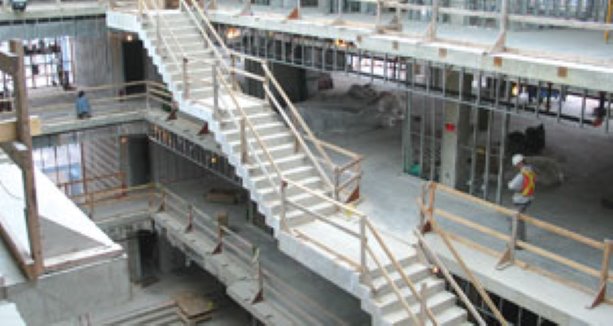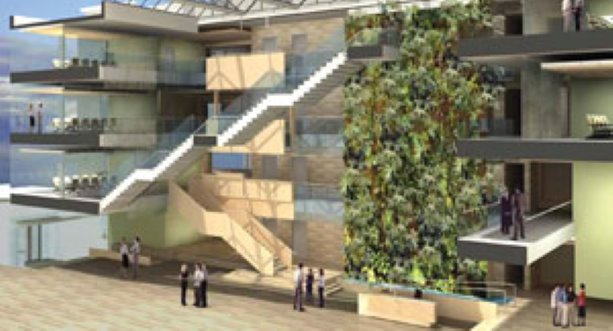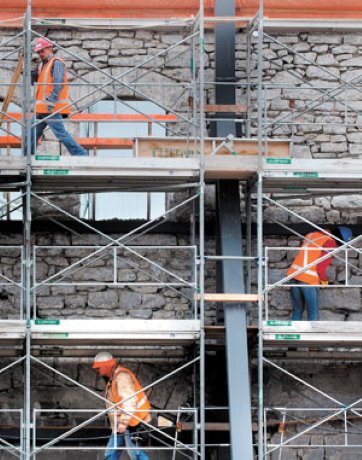Some say it’s a trend; others say it’s too soon to tell. But one thing’s for sure: Building green is a principle that’s catching on like wildfire in Ontario municipalities west of Toronto.
Municipal Designs
LONDON
Some say it’s a trend; others say it’s too soon to tell. But one thing’s for sure: Building green is a principle that’s catching on like wildfire in Ontario municipalities west of Toronto.
Guelph, Kitchener, Cambridge and Oxford County are among the municipalities that have embraced sustainable building for new civic building projects, three of which involve erecting flagship municipal administration buildings.
“There’s a very green mindset in the community as a whole,” says Jeff Christy, who is managing the construction of a new administration building for the City of Guelph. That mindset is reflected on the city’s council, which gave staff the mandate to build green from the outset of the project, he said.
Mario Petricevic, a projects manager with the City of Kitchener, credits his city’s council for being a driving force behind the development of a green sports centre that will house a twin ice pad and Slobodanka Lekic, a project manager with the City of Cambridge, similarly credits her council for supporting the application of sustainable building principles to that community’s new administration building.
Cambridge is aiming to make its building the first LEED (Leadership in Energy and Environmental Design) certified gold city hall in the country.
“We are so proud that we’re doing this,” Lekic said. “Really, these days the environment is so important.”
At the County of Oxford, the political support has certainly been there for developing a green administrative building that is well under way and is scheduled for completion next March.
But it’s not all about environmental idealism, noted Robert Walton, the county’s director of public works.
Achieving long-term energy savings is also a big driver.
The county anticipates achieving a 25 to 40 per cent range of savings on these costs compared to a conventionally-constructed building, he said.
While it means having to spend a little more at the outset, it will take only about two to four years of operation to see a payback on some features. “We’ve heard costs between five and 10 per cent to add in these extras,” Walton said.
Those involved in the three civic administration building projects all mention a show of leadership as being another key factor motivating the adoption of green practices.
For the Oxford project, that has meant selecting a brownfill site as the location of the new building and adding a rainwater reuse cistern. It’s not expected the cistern, which will provide water for toilets and urinals, will pay for itself, “but we’re water providers so we thought we should show leadership (in this area),” Walton said.
Below, a cutaway, sectional view of how the atrium will look when completed
In Cambridge, the municipality’s administration building is the first step towards promoting the benefits of sustainable building, Lekic said.
“We’re already thinking whenever we have a roof for replacement it will be a green roof,” she said.
In Guelph, it’s anticipated the building will “act as a beacon for the community” and “encourage developers to consider the approach,” said Christy.
Christy, who works for MHPM Project Managers Inc., said he’s one of five project managers working with municipalities to obtain LEED accreditation.
Leading by way of example is by far the preferred approach, he said, pointing out that municipalities don’t want to discourage developers. This way, it’s “not asking them to do something we’re not asked to do ourselves.”
Rick Mocellin, an architect with the London-based firm Tillmann Ruth Mocellin, pointed out that the broader development community isn’t yet sold on the benefits of green building, noting they come with a premium cost.
The firm is working with EllisDon in a design/build arrangement for the Oxford County facility.
But the costs are getting better, he said.
Christy agreed, pointing out the building standard LEED certification uses as the base to compare green build initiatives is becoming outdated.
Many of the materials and equipment currently available on the market are of a much higher standard and consequently, the premiums paid aren’t “as much as you think,” he said.
As for the Guelph project, at the end of the day, the “incremental cost (to adopt the green features) was hundreds of thousands and not in the millions – and in the low hundreds of thousands,” he said.

1/2
Construction of Cambridge's new environmentally-friendly civic administration building atrium stairwell and remaining building is well under way

2/2
A cutaway, sectional view of how the atrium will look when completed











Recent Comments
comments for this post are closed